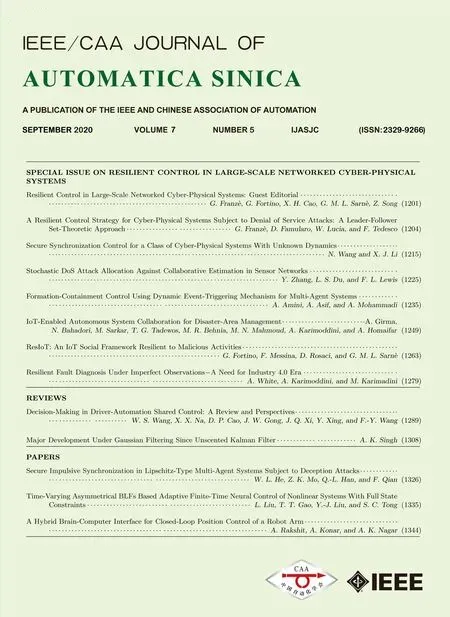Finite-time Control of Discrete-time Systems With Variable Quantization Density in Networked Channels
Yiming Cheng, Xu Zhang, Tianhe Liu, and Changhong Wang
Abstract—This paper is concerned with the problem of finitetime control for a class of discrete-time networked systems. The measurement output and control input signals are quantized before being transmitted in communication network. The quantization density of the network is assumed to be variable depending on the throughputs of network for the sake of congestion avoidance. The variation of the quantization density modes satisfies persistent dwell-time (PDT) switching which is more general than dwell-time switching in networked channels.By using a quantization-error-dependent Lyapunov function approach, sufficient conditions are given to ensure that the quantized systems are finite-time stable and finite-time bounded with a prescribed performance, upon which a set of controllers depending on the mode of quantization density are designed. In order to show the effectiveness of the designed controller, we apply the developed theoretical results to a numerical example.
I. Introduction
THE past decades have witnessed a rapid advance in studies of networked control systems (NCSs) which are widely applied in power networks [1], fuzzy systems [2], fault detection [3], etc. NCSs, which consist of dispersing system components and signal transmission networks, have more compatibility and application diversity compared with integrated control systems whose system components, such as actuators,controllers, and sensors are located at the same place. Since information exchange between system components heavily rely on the performance of communication networks, many efforts have been devoted to this field, which is seen in [4]–[6]and the references therein.
Although various advantages such as increased flexibility and reduced cost are associated with NCSs, the applicability of communication networks can be seriously affected by limited network capacity, which is generally caused by network congestion. In order to reduce the amount of data transmission, signals should be quantized before transmitted.In practice, network throughput may vary in order to improve system performance, and as a result quantization density should also vary, which may lead to a varying quantization error. Such variation can be modeled via switched system theory, i.e., each quantization density can be regarded as a subsystem mode and the overall networked control system is therefore regarded as a class of switched system. One can address the variation of quantization density using persistent dwell-time (PDT), since its actual variation sequence can hardly be obtained. A PDT switching signal refers to a class of switching signal composed of infinitely many dispersed intervals in which the subsystem mode remains stationary. In the intermissions of such intervals, however, the subsystem mode can randomly switch. Compared with other kinds of switching signal [7]–[9], only a small amount of the current literature has addressed the problems of PDT switching signal.
The controller design problem has been extensively probed for conventional dynamic control systems, and various control strategies are extended to network-based case [10]–[12]. It should be noted that the majority of existing works are based on the hypothesis that a quantizer is associated with only control input or measurement output, and the quantization density is assumed to be invariant. Obviously such assumptions are ideal and may result in an increased quantization error or degraded system performance. Although some efforts have been devoted to addressing the problem of variable quantization densities [13], [14], to the best of our knowledge, the controller design problem for NCSs with quantized control input and measurement output subject to variable quantization densities remains open.
In order to prevent saturation caused by excessive state value of the system, the concept of finite-time stability was introduced in 1953 [15]. Compared with conventional asymptotic stability in Lyapunov sense, finite-time stability is concerned with the state of the systems at each time instead of the trend of system. Therefore, finite-time stability is of practical significance in many fields such as power electronics[16], networked systems [17], flight control systems [18].Despite the fact that studies of finite-time stability can be found in many literatures [19]–[22], finite-time stability of NCSs, especially NCSs with variable quantization density is the designed H∞controller has been manifested.






To elucidate the influence of the obtained H∞performance index γlin different quantization error bounds of the two modes, one assumes that all parameters remain the same,moreover

By simulation and calculation, one can obtain the H∞performance index γlin different quantization error bounds of two modes as shown in Fig.5. It is easy to see that γlgrows with the increase of δ1and δ2. Moreover, there exists upper bound δmaxto δ1and δ2. As shown in Fig.5, the rate of γlgrowth is faster when δ1or δ2is close to the upper bound. In addition, there is no feasible solution, if δ1or δ2is greater than δmax=0.54. Fig.6 is given to illustrate that γlgrows with the increase of α in different quantization error bounds.

Fig.5. γl in different quantization error bounds of two modes.
V. Conclusion
This paper investigates the finite-time control problem for a class of NCSs with signal quantization density variation. A quantization error dependent Lyapunov function is adopted,and the finite-time bounded analysis and H∞performance analysis are carried out. Based on the analysis results, a set of H∞controllers suitable for the interested NCSs are designed to guarantee finite-time boundedness along with H∞performance. A numerical example is provided to illustrate the validity and potential of the developed results. We will carry out practical systems in order to support theoretical results in the future work.

Fig.6. γl for different α in different quantization error bounds.
 IEEE/CAA Journal of Automatica Sinica2020年5期
IEEE/CAA Journal of Automatica Sinica2020年5期
- IEEE/CAA Journal of Automatica Sinica的其它文章
- Resilient Fault Diagnosis Under Imperfect Observations–A Need for Industry 4.0 Era
- Variational Inference Based Kernel Dynamic Bayesian Networks for Construction of Prediction Intervals for Industrial Time Series With Incomplete Input
- Arbitrary-Order Fractance Approximation Circuits With High Order-Stability Characteristic and Wider Approximation Frequency Bandwidth
- Time-Varying Asymmetrical BLFs Based Adaptive Finite-Time Neural Control of Nonlinear Systems With Full State Constraints
- Secure Impulsive Synchronization in Lipschitz-Type Multi-Agent Systems Subject to Deception Attacks
- Decision-Making in Driver-Automation Shared Control: A Review and Perspectives
